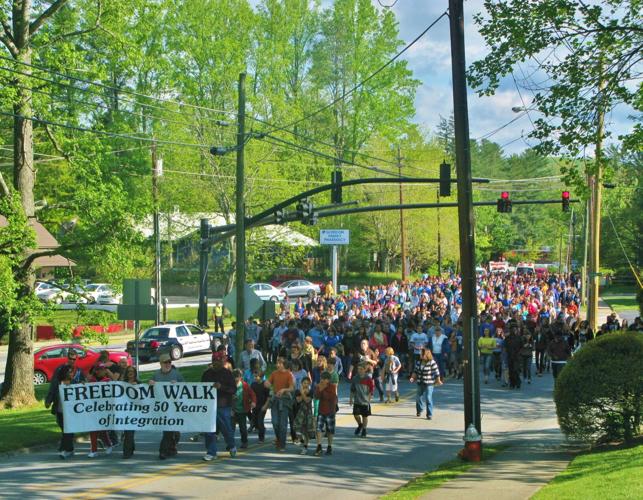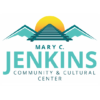Rosenwald News – November 1, 2022

This year marks my 11th year of community work in Transylvania County, with the last 10 of it being devoted specifically to the Rosenwald community. I wanted to take time to reflect upon some of what happened on my watch so to speak, especially the beginning days, as this will be my last Rosenwald News article.
Towards the end of 2012, I was in the City Planning Department office meeting with then City Planning Manager Josh Freeman. I was doing volunteer work with a group called Imagine Brevard at the time and wanted some information about rules and restrictions related to the downtown planters and outdoor murals. Towards the close of the meeting, we got to talking about some of the other creative, artsy things that I was doing in the community, particularly with youth. We had just held a successful teen whiteout party for middle and high school students and I was planning performance art events for the following year. Josh asked if I’d be interested in doing something similar to what I was already doing, but with another part of the community. I had to go, but I mulled that over in my head for a week and felt intrigued and reached back out to discover what Josh had in mind. That was towards the end of 2012. His subsequent invitation was for me to come on board to engage an isolated part of our community, to help build a bridge between the city and Rosenwald in ways that were not typical for the city. I accepted the role of Rosenwald community liaison and project leader and haven’t turned back since. While my volunteer/contract work with the Planning Department ended in early 2016, my work with and on behalf of the community continued.
Sheila Mooney was the first person that I reached out to because she lived within the historic Rosenwald neighborhood and like most people back then I knew absolutely nothing about Rosenwald other than my associating it with the two signs on the side of Cashiers Valley Road and Mills Avenue, respectively. Sheila began animatedly talking about relevant history, facts I should know and who I should meet. She effectively took me by the hand, introduced me to a group of Rosenwald alumni and to Edith Darity, who in turn introduced me to the group of Mary C. Jenkins Community Center board members at that time (Randy Lytle, Lewis Whiteside, Karen Darity and Robert Hutchison.) The community became my outdoor office bringing meetings to people wherever they were at, reporting back for supervision and support. Freeman’s leadership style was respectful, immersive, supportive and empowering. This collaborative team approach gifted us all freedom in a respectful and dynamic way providing space and opportunity for us to come into our own and that we did! We all worked together as a well-functioning, cooperative unit enjoying the process, the journey and the fruits of our labor. In many ways, it has felt like one elongated party with a few of my best friends.
The early years really stand out for me. We began the process of getting to know each other, of organizing and meeting with regularity, bringing the partnership with the city into the mix. We identified what we wanted to accomplish, again with the city interfacing with input and support.
Janice Pinson, administrative services manager with the Planning Department, shared her thoughts with me: “He (Josh) was totally devoted to and determined to the betterment and recognition of the Rosenwald Community. His sense of value to all community was and is amazing. I do remember the first Rosenwald Community Block Party, cleaning out the stream, Josh in his waders pulling all kinds of litter out of the stream. The continuation of what Josh started lives on today with the annual Rosenwald Block Party. Remember when you and the Planning Department guys did the Bailey Cemetery project, the historical signs that have been placed in the Rosenwald Community and your energetic part of making it happen?” Yes, Janice, I do remember with much fondness, thank you.
Thank you to Aaron Bland, assistant planning director, for his added recollection: “What sticks out to me the most was visiting the Bailey Cemetery. As someone who grew up in Brevard, it was pretty astounding to walk up that hill and find this completely hidden piece of history. I went up there a few times and it was always a unique feeling to walk around in seclusion, not only physically speaking in that it’s away from streets and noise, but almost in a sense of time. In the years since, I’ve mentioned it to several people and none of them knew it was there either. I’ve also learned about how, decades ago, Rosenwald was an almost self-sufficient community with all kinds of businesses such as stores and services in part because it had to but also because it could. I’ve always known that Rosenwald was very connected to their community’s history, but when you hear stories about how the old community center had a pool because they weren’t allowed to go to the public pool, it makes a lot of sense that those who lived through those times are working hard to make sure it isn’t forgotten.”
I do believe with our efforts then and now, we are ensuring that this history is celebrated and cherished, with room to grow and make new memories.
Most of the initial events that were created, for example the Rosenwald Art Festival in the Rogow Room, the 2013 Freedom Walk celebrating 50 years of integration of the schools, “Painters & Poets” upstairs at The Haen Gallery, bringing Pearl Fryar at the end of that year to speak to the community … all had the purpose of engagement and enjoyment while promoting awareness and education about this rich but mostly unknown local black history. Activities were mostly orchestrated at the onset with a group of alumni in conjunction with the planning department. Later, we extended the invitation for broader partnership to include the MCJCC board and other community groups in events and activities. The MCJCC group’s earlier days had more to do with organization, meeting on a consistent basis to now include the city, going into the old community center to take stock of what was what, getting new surveys done on the building and property with estimates to repair versus take down to rebuild, all with an eye to once again having the doors reopened. The whole crazy adventure began of involving legal counsel, sorting out titles and crisscrossing property lines, contacting relatives, getting community surveys done, etc. Further down the road, things broadened to what most people are aware of today involving fundraising efforts like the 2015 revitalization film project with Mountain Sun middle school students, the joint City/Rosenwald Task Forces and reporting to City Council.
So many deserving highlights for me, but here are a few: the introduction of the block party to this community. I am sure that it may have felt like a headache for some (thinking especially of Janice Pinson) as there was no template to follow. We were grateful though. I remember the evening before that first outdoor block party, what a delight to see the tent getting set up, the port-o-potties being delivered and having to be padlocked until the morning, tables and chairs … just everything. The next day, an early morning tannery walking tour followed by dancing, music, hot dogs, community garden planting, cleaning up the creek as part of the Norton Creek restoration project, the arrival of the ice cream truck, the recycling education van, informational displays about things to come along with multiple opportunities for people to share and offer input.
The day we first went into the old, boarded up, community center, I felt like I was on an exciting and adventurous field trip. Seeing things still up on the walls like the giant painting of George Washington Carver, items left on shelves and bookcases, the wooden floors and stage, the old shutters covering the windows, the podium, the trash cans that actually said Rosenwald, the original community sign and musical equipment and neat materials that gave me a glimpse back in time. The surrounding conversations about the structure. I wanted to record it all. Josh talking about the route that the train used to take past the center stopping at the tannery before heading up the mountain. That led to my gathering so many anecdotes from the Rosenwald community, especially about the train passing through, the swimming pool at the center and the tannery down the road. I started documenting and gathering what I was witnessing with my camera and with handwritten notes. Like Aaron, Bailey’s cemetery stands out. We had to get permission to cross a creek on someone’s property and venture up the hill to begin the process of measuring and cataloging what we discovered. I remember so many input sessions and surveys conducted with youth and adults. What did they want in their community, either in general, or at the future community center, the playground and nearby Tannery Park? Going door to door on foot with Josh, Aaron, Daniel Cobb, two other planning department staff and myself to hand out and help people complete community surveys. I remember taking people onto the tannery property, compiling a list of birds, wildlife, learning about the habitat.
There isn’t enough space to share this all here, but I do have pictures, audios and videos that I will continue to post in places that the public can enjoy. I am entirely thankful to The Transylvania Times (editors John Lanier and Derek McKissock) for the privilege to write and submit articles on a volunteer basis on behalf of the community. I feel humbled and happy that the new Mary C. Jenkins Community & Cultural Center has a link to these newspaper articles on their website and laminated copies in house. My journey with our community has been rewarding in so many ways. Thank you.
To close us out, my Rosenwald conversation began in Rosenwald with my colleague (we worked together in the 1990s at Trend Community Mental Health Center in Brevard) and dear friend, Sheila Mooney. Fitting to end with a few words from her: “We had so many great projects: block parties on the playground, Rosenwald reunions, but the 50th anniversary of school integration may be my favorite. When we talk there is a creative flow that brings joy to life. Twenty plus years ago we met and became sisters. With such ease, our friendship blossomed and continues to bring a safe place for us to give and grow. What a gift you are for this community and me. So, no matter where you go, you will have a home in our hearts and Brevard. Thank you for all of your time, talent and love that you have given to us. You are a gem!”
The feeling is entirely mutual, not just for my friend but for a community that I hold dear in my heart. Thank you for opening your hearts and homes to me. Thank you for offering me a seat at a shared community table, speaking truths about what matters. Signing off for the last time in this space.
